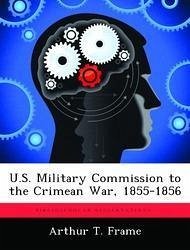Nicht lieferbar

U.S. Military Commission to the Crimean War, 1855-1856
Versandkostenfrei!
Nicht lieferbar
This study examines the U.S. Military Commission sent by the Secretary of War to observe the Crimean War in 1855 and 1856, to determine why the commission was sent, where it went, and the results achieved by the commissions efforts. A survey of the literature on the U.S. involvement in the Crimean War in general, and the Military Commission specifically, indicates that little has been written on either. It is shown that while the official policy of the United States was strict neutrality, many private citizens involved themselves in the conflict. The nation was able to use the conflict to real...
This study examines the U.S. Military Commission sent by the Secretary of War to observe the Crimean War in 1855 and 1856, to determine why the commission was sent, where it went, and the results achieved by the commissions efforts. A survey of the literature on the U.S. involvement in the Crimean War in general, and the Military Commission specifically, indicates that little has been written on either. It is shown that while the official policy of the United States was strict neutrality, many private citizens involved themselves in the conflict. The nation was able to use the conflict to realize one of its age-old goals: recognition of the rights of neutrals on the seas. The U.S. Military Commission was the only official involvement in the conflict. In a time of rapid national expansion and minimum military manpower resources, the three-man commission was sent to study the art of war as it was being practiced in Europe. It was to study the "new" technology in fortifications, and armaments, and the organization of European armies to see if there might be some application to improve the effectiveness and capability of the U.S. Army in defending the vast new territory. Although extensive reports were written by the commission, little was incorporated until well into the Civil War. This work has been selected by scholars as being culturally important, and is part of the knowledge base of civilization as we know it. This work was reproduced from the original artifact, and remains as true to the original work as possible. Therefore, you will see the original copyright references, library stamps (as most of these works have been housed in our most important libraries around the world), and other notations in the work. This work is in the public domain in the United States of America, and possibly other nations. Within the United States, you may freely copy and distribute this work, as no entity (individual or corporate) has a copyright on the body of the work. As a reproduction of a historical artifact, this work may contain missing or blurred pages, poor pictures, errant marks, etc. Scholars believe, and we concur, that this work is important enough to be preserved, reproduced, and made generally available to the public. We appreciate your support of the preservation process, and thank you for being an important part of keeping this knowledge alive and relevant.








![A Lecture Delivered Before the Brockville Library Association and Mechanics' Institute [microform]: Introductory to the Course of Lectures for 1855 Cover A Lecture Delivered Before the Brockville Library Association and Mechanics' Institute [microform]: Introductory to the Course of Lectures for 1855](https://bilder.buecher.de/produkte/66/66201/66201079n.jpg)


